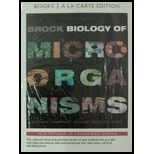
Escherichia.coli is a Gram-negative, rod-shaped, facultative anaerobic bacteria. The species of Escherichia coli are inhabitants of the human intestinal tracts. It plays a nutritional role by generating vitamins, mainly vitamin K. Most of the strains of E.coli are harmless, while the others cause abdominal cramps, vomiting, fever, dehydration, bloody diarrhea, and even kidney failure. It is a mixed-acid fermenter.
Klebsiella is a Gram-negative, nonmotile, rod-shaped, oxidase-negative bacteria. It causes hospital-acquired urinary tract infections, pneumonia, septicemia, and soft tissue infections. It is a butanediol fermenter.
Want to see the full answer?
Check out a sample textbook solution
Chapter 15 Solutions
Brock Biology of Microorganisms, Books a la Carte Plus Mastering Microbiology with eText -- Access Card Package (14th Edition)
- Name four different pathogenic groups of Escherichia coli.arrow_forwardWhat Enterobacteriaceae are of medical significance?List and describe the infections caused by these organisms.arrow_forwardWhat are the cardinal temperatures for Escherichia coli? Towhat temperature class does it belong?arrow_forward
- What bacterial genus is commonly found in the intestines of birds and reptiles? A) Neisseria B) Salmonella C) Rickettsia D) Bacillus E) Treponemaarrow_forwardWhich coliform bacteria are the most difficult to distinguish from the Salmonella or Shigella pathogens? What is the primary characteristic used to differentiate them?arrow_forwardCharacterize and give a brief description of the following bacteria: Salmonella enteritis Yersina Pestisarrow_forward
- Define and sketch the following: A) bacillus B) coccus C) strepto D) staphylo What is the differance between "Bacillus and bacillus"?arrow_forwardUsing a microscope, how could you distinguish the cocci that cause staph infections from those that cause strep throat?arrow_forwardWrite a brief description of Escherichia coli, Yersinia Pestis, Yersinia enterocoliticaarrow_forward
